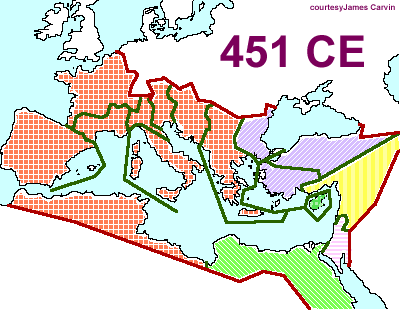 |
|||||||||||||||||||
|
|||||||||||||||||||
Ecc514 - Orthodox Ukrainian jurisdictions |
|||||||||||||||||||
Lesson 1: Early Church Jurisdictions - 7
The primacy of Rome was not ecclesial, and certainly not Biblical. It was geo-political. Rome was the capital of the known world. That it should have eventually enjoyed any sort of supreme authority among the churches should come as no surprise. Any reasonable person should be able to understand that the high regard some ancient writers had for popes in Rome was a reflection of their regard for the church in Rome. With all due respect to the bishops of Rome, it was the church that made the bishops there great. It wasn't the bishops that made the church there great. There is no reason to believe that the church was blindly following the Roman misinterpretation of Mt 16:16-19 (the keys of Peter) as it did in the West centuries later. Certainly Antioch did not abuse this verse the way the Romans did. Tertullian, writing in the early third century was already found mocking the Roman bishop for his misuse of this text. We can see from the map to the right that Rome was at the center of the known world at the time, and as we have already pointed out, the whole traverse of Christianity had taken place on Roman built roads. Naturally, then, the church paralleled the Roman kingdom in its reaches. Additionally, all communication had to take place on foot in those days. Languages also divided peoples. To oversee responsibly a church hierarchy with bishops overseeing many churches and archbishops overseeing larger areas and so on made good sense because it was based on intimate knowledge of the flock. Moses had done the same thing under the advice of his Uncle Jethro in managing Israel (Ex18:21,25;Dt1:15). The Christian West was thus divided up into major metropolitan areas. The three ancient Christian centers of Jerusalem, Antioch and Alexandria were roughly the same size as these Western metropolitan areas. They were exceeded in measure by the rapid expansion and popularity of the Christian faith especially after the Edict of Milan in 325 C.E.. Antioch was elevated from "Metropolia" to "Patriarchate" in 451 C.E. at the Council of Chalcedon. It was all about growth and strategic assignment as the bishops saw fit as they prayed about how to best serve their flocks.
|
|||||||||||||||||||
|
|||||||||||||||||||
 The growth of the church of Rome was not as simple as Peter and Paul arriving there and establishing it, as many have been falsely taught. To speak of successors of Peter is one thing. To consider the complexity of the growth of the entire kingdom is quite another. Indeed, if the Roman episcopacy is considered the successorship of Peter, then what are we to make of the patriarchate of Antioch, which also was founded by Peter?
The growth of the church of Rome was not as simple as Peter and Paul arriving there and establishing it, as many have been falsely taught. To speak of successors of Peter is one thing. To consider the complexity of the growth of the entire kingdom is quite another. Indeed, if the Roman episcopacy is considered the successorship of Peter, then what are we to make of the patriarchate of Antioch, which also was founded by Peter?